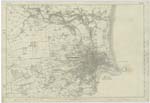OS1/1/1/1B
| List of names as written | Various modes of spelling | Authorities for spelling | Situation | Description remarks |
|---|---|---|---|---|
| ABERDEEN | Aberdeen Aberdeen Aberdeen Aberdeen Aberdeen Aberdeen |
Stewart's Modern Geography Burgh Boundary Reports for Scotland Johnston's County Map of Aberdeen Oliver and Boyd's Almanac 1865-66 Post Office Directory 1866-67 Fullerton's Gazetteer Volume 1 |
075 | [Continued] "the city was honoured with visits from the then reigning sovereigns, and on 7th September 1848 Her Most Gracious Majesty, Queen Victoria, the Prince Consort and part of the Royal Family honoured the City with a visit also, on their way to the palace at Balmoral, about 50 miles westward. New and Old Aberdeen are names which are apt to mislead. What is now called Old Aberdeen was originally called Kirk Town of Seaton, and it was not till after the burning of Aberdeen by the English in 1336, when, Phoenix-like, it rose again from its ashes, that it was called New Aberdeen, while, in reality, it is by far the more ancient of the two. The City records commence so early as 1398, and are nearly complete to the present time. They afford interesting materials for a history of its rise and progress from a village of about 3,000 inhabitants, to and elegant, populous, and wealthy city. The original buildings seem to have been situated in the vicinity of the Green and Shiprow, and to have gradually extended over the eminences known by the names of St Catherine's hill (part of which was levelled in laying out Union Street,) Broad Street, Gallowgate, Porthill, Schoolhill, and Woolmanhill. The Castlehill was unquestionably occupied as a military station in very remote times, but there were no houses on the south side of Castle Street hill after the commencement of the 16th Century; and the low grounds adjoining the Quay, now occupied by Virginia Street, James Street, lower half of Commerce Street etc., were not recovered from the tide till about the middle of the 17th Century. Many of the present streets, such as Queen Street, Marischal Street, Belmont Street etc., and much of the suburb called Gilcomston, were all built during the latter part of the last century. Since which period the alterations, improvements, and extension of the city have been truly astonishing. Aberdeen, as it now appears, is chiefly of modern date. The old wooden houses which stood in some of its principal streets have long since disappeared, and been replaced by elegant edifices of granite; - in short, the greater number of its streets and public buildings have been erected since the commencement of the present century. The approaches to the town are spacious; and, as they are carried in direct lines, the old, narrow, and circuituous streets and lanes are entirely one-sided. In entering from the north-west by George Street, or from the north-east by King Street, the former will be found wide and regular, the latter, handsome and elegant; - but the approaches from the south and west are most splendid. These meet at Union Place, and thence proceed in a straight line through Union Street to Castle Street, which is said to be the largest market place of any town in Scotland. The Parliament boundary of the burgh as defined by the Reform Act of 1832, includes the Old Town, and a great portion of ground belonging to the Parish of Old Machar; which Parliamentary burgh has been divided for the convenience of polling into 5 wards or districts. The present Member of Parliament for the City is Colonel W.H. Sykes. The number of Parliamentary voters on the roll during 1865 was 3872. Under the Reform Act, the Magistrates and Councillors are elected by the Parliamentary electors within the burgh, which is, for convenience of polling, divided into 3 Municipal Wards, each of which sends 6 representatives to the Town Council -" |
Continued entries/extra info
[PAGE] 1bTranscribers who have contributed to this page.
Moira L- Moderator, ElaineF
Location information for this page.
Linked mapsheets.




